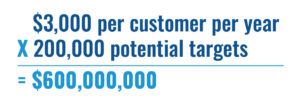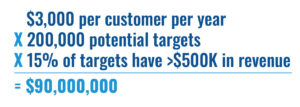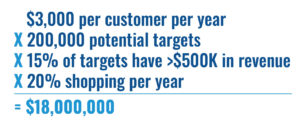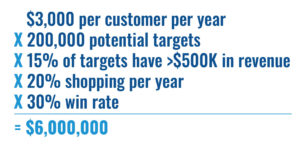How to calculate annual market vend – a better way for recurring revenue companies to think about TAM
You’ve certainly estimated the size of your total addressable market (TAM), and you’ve probably built out strong funnel models to map out your marketing and sales plan. But have you ever calculated your market’s vend? Vend is a measure of how much business will transact in your market each year and understanding vend is hugely important for calibrating your company’s market focus.
The concept of vend is particularly important for recurring revenue businesses. Even when they don’t sign multi-year contracts, customers often stick with their software providers for multiple years. As a result, not every target is “up for grabs” in any given year.
And even among those targets that do transact, not every opportunity is an ideal fit for your company’s products. Vend calculations help you gauge how much of your TAM you could realistically book in any given year.
Calculating your company’s “fair share” of annual vend
To illustrate, imagine a fictional company that sells patient scheduling software to medium-to-large dentists offices. The company is successful and growing, with $5M in ARR and looking to double next year. It seems like the dental scheduling market should be more than big enough to support the company’s planned growth, but a $5M bookings goal is twice as much as they’ve ever booked in a single year.
Some quick vend math can help the company decide whether they should stay focused and execute or start to think about TAM expansion strategy.
1. What’s your TAM?
The average cost of the company’s software is $250 per month, or $3,000 per year. North American Industry Classification System (NAICS) data suggests there are over 200,000 dentist offices in the US, so the TAM should be $600M+. At first blush, it appears there is a ton of room for this small company to grow.
To calculate your overall TAM:


2. What % of your TAM is addressable, with your current product and business model?
Let’s say our dental scheduling software company has discovered that smaller offices have a much lower willingness to pay and churn at a much higher rate. Further, the company has identified a better fit with offices that bring in $500K or more in annual revenue. Focusing on this more attractive segment is a smart move from a sales efficiency and retention perspective but narrows the market considerably. Only about 30,000 dentists (about 15% of potential targets) have revenues over $500K.
Adding addressability criteria helps you narrow down a large TAM to identify the size of your target segment(s).


3. What % of your addressable market is “shopping” in any given year?
In most businesses, switching core software is a massive pain. As a result, most businesses only consider switching out key pieces of software every few years. In general, that period seems to be longer (5-8 years) for a core operating system/ERM, and might be shorter for point solutions. That means that in established markets with limited greenfield, the number of potential deals each year is limited by how often prospects evaluate new solutions.
Let’s assume most dentists already have some kind of scheduling solution in place, and are only open to switching on average every five years. So in any given year, only about 20% of the market is “shopping” for a new solution.
Adding shopping rate helps you identify your target market’s annual vend—the sum of all transactions that will happen in your space in a given year.


4. What % of opportunities do you win?
Finally, no business has a perfect win rate. In competitive markets, you’re bound to lose some deals to competitors, and when evangelizing a new market, you’re bound to lose some deals to inaction when a prospect just isn’t ready to make a decision. Let’s assume the dental scheduling software company has a healthy 30% closed-won rate.
Adding win rate helps you identify your company’s “fair share”—if you had perfect go-to-market execution and were in every deal in your space in a year, what would your bookings be?


Using vend calculations to make better strategic decisions
The dental software company is aiming to do $5M in new bookings next year, but its “fair share” of market vend is only $6M. That means that in order to succeed in its $5M bookings goal, it needs to see at least 80% of the deals that transact in its target segment, and maintain its 30% win rate—a tall order.
The company should make sure it’s at the top of its game when it comes to sales execution and should likely start to consider how it can expand its sweet spot to continue to sustain growth.
When looking to squeeze more bookings out of your target market, evaluate these 4 levers:
- Charge more per customer – Raise prices, or identify add-on products that can be packaged into new deals and upsold into your customer base
- Increase the number of targets that are addressable – Make modifications to your products or processes that allow you to move up/down-market or into an adjacent vertical. But be careful to expand methodically, versus adopting a “spray and pray” sales and marketing approach.
- Persuade more targets to shop – Increase annual vend by convincing more targets they need to evaluate your solution; good product marketing and sales enablement can help. Targeting prospects using clunky, legacy, on-prem solutions can be a good tactic, as they may be less satisfied with their current setup.
- Increase your win rate – Of course, you can increase bookings by winning more deals. If that’s a concern, make sure your sales process is buttoned up, invest in sales training, and audit your AEs productivity.
Calculating vend can also give you confidence that your target market is big enough. If your “fair share” of vend exceeds your bookings goals by a comfortable margin, avoid the temptation to get distracted by expansion. In that fortunate circumstance you’ve likely stumbled upon a successful product fit and go-to-market recipe, and the most cost-effective way to grow would be to do more of what you’re doing.
The information herein is based on the author’s opinions and views and there can be no assurance other third-party analyses would reach the same conclusions as those provided herein. The information herein is not and may not be relied on in any manner as, legal, tax, business or investment advice.
Certain information contained in this content piece has been obtained from published and non‐published sources prepared by other parties, which in certain cases have not been updated through the date hereof. While such information is believed to be reliable for the purposes of this content piece, neither Mainsail nor the author assume any responsibility for the accuracy or completeness of such information and such information has not been independently verified by either of them. The content piece will not be updated or otherwise revised to reflect information that subsequently becomes available, or circumstances existing or changes occurring after the date hereof, or for any other reason.
Certain information contained herein constitutes “forward-looking statements,” which can be identified by the use of terms such as “may,” “will,” “should,” “could,” “would,” “predicts,” “potential,” “continue,” “expects,” “anticipates,” “projects,” “future,” “targets,” “intends,” “plans,” “believes,” “estimates” (or the negatives thereof) or other variations thereon or comparable terminology. Forward looking statements are subject to a number of risks and uncertainties, which are beyond the control of Mainsail. Actual results, performance, prospects or opportunities could differ materially from those expressed in or implied by the forward-looking statements. Additional risks of which Mainsail is not currently aware also could cause actual results to differ. In light of these risks, uncertainties and assumptions, you should not place undue reliance on any forward-looking statements. The forward-looking events discussed in this content piece may not occur. Mainsail undertakes no obligation to update or revise any forward-looking statements, whether as a result of new information, future events or otherwise.
No representation, warranty or undertaking, express or implied, is given as to the accuracy or completeness of the information or opinions contained in the enclosed materials by Mainsail and no liability is accepted by such persons for the accuracy or completeness of any such information or opinions. For additional important disclosures, please here.

